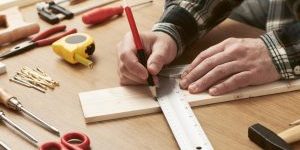Radon is a radioactive Class A carcinogen gas. Installing a radon mitigation system is serious business; without the proper knowledge and tools, it can result in worsening a faulty system, or even increasing your radon levels. If you’ve already measured your radon levels and they’re 4 pCi/L or higher, you know you need a radon reduction system to keep your home safe. A do-it-yourself radon mitigation job may seem like the cheapest option, but unless you know the ins and outs of mitigation and how to install the system properly, it could be more trouble than it’s worth.
There are many guides online on installing a DIY radon mitigation system, but most of them don’t consider certain important factors. These factors include what part of the country you live in, the type of basement you have, what kinds of fans you need, and whether or not you have a sump basin. With the right research and resources, DIY radon mitigation is possible, but trusting an expert radon removal contractor will ensure your safety.
What Can Go Wrong with DIY Radon Mitigation?
While the mechanics of a radon reduction system are simple in theory, they are much more complex in execution: A poorly-installed do-it-yourself radon mitigation system could cause serious issues.
Some potential issues associated with DIY radon mitigation efforts are:
- Backdrafting: Professionals have equipment and knowledge to ensure that the suction of the radon system does not inadvertently pull carbon monoxide from the furnace and water heater flues back into the home, which is a potentially deadly problem.
- Sub-slab Conditions: Radon mitigation systems work best when there is gravel under the concrete slab. If dirt, or worse, clay, is found directly under the concrete, the system usually needs to be redesigned. Knowing what type of redesign is necessary based on the porosity of the soil is tricky, and only comes from experience.
- Piercing Hidden Pipes: Good professionals have equipment and knowledge that help them avoid hitting hidden pipes or electrical conduits buried in the concrete or dirt.
- Radon Reentry: Wind and building dynamics need to be considered where the system discharges the radon-filled air to avoid the radon from reentering the house through open windows, walls, vents, or skylights.
- Condensation Problems: Radon mitigation systems handle humidity-laden air. The condensation that occurs within the pipe at some times of the year can mean that large amounts of water appear in certain areas of the piping system. Special care is needed to direct the water in a way that will not reduce the system’s effectiveness or cause flooding or gurgling.
- Issues at Building Sale: In Illinois, when a home is sold, the buyer is usually looking to see if the system was installed by a professional. A do-it-yourself radon mitigation system may trigger a request for a system to be reinstalled by a professional, or could even scare them away.
- Diagnostics: The most complex part of radon mitigation can occur if the system fails the re-test after it is installed. Expensive equipment and extensive knowledge is often needed to find the hidden radon “hot spots” and to redesign the system to effectively eliminate them.
- Warranties: Most professionals offer a warranty that the system will pass the radon test and will keep radon levels low for a number of years. If you choose a professional team and any of the above (or other) issues become a nightmare, it’s the professional’s nightmare, not yours.
While there are various options for radon mitigation, such as passive and active systems, without a professional opinion, it’s hard to know which is best for your home and compliant with state regulations. Installing a unit that won’t remove enough radon or a fan that doesn’t provide enough suction could result in necessary changes down the line and puts your family’s health in danger. With different basement or crawl space floorings, such as gravel, dirt, or concrete, a membrane may be necessary to collect radon gas as it discharges. All these factors make professional installation the preferred option over DIY radon mitigation.
Trust the Experts
For installation of a radon remediation system in the Chicago area, trust the experts at DuPage Radon Contractors. They’ve installed over 12,000 systems and will work with you to make your home or business safe as quickly as possible. You’ll get a quote the same day the team comes out to make your consultation. Most systems can be installed in 24 hours and usually range between $1000-$2500. Each system is custom-designed for your location and is 100% guaranteed to remove radon for five years with a five-year part warranty. Contact DuPage Radon Contractors today and avoid the mistakes associated with DIY radon mitigation.





